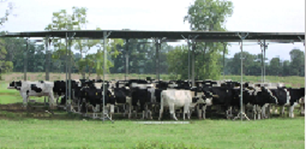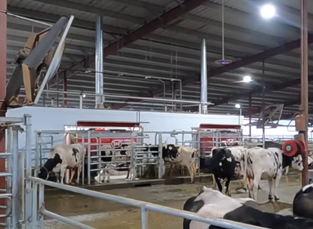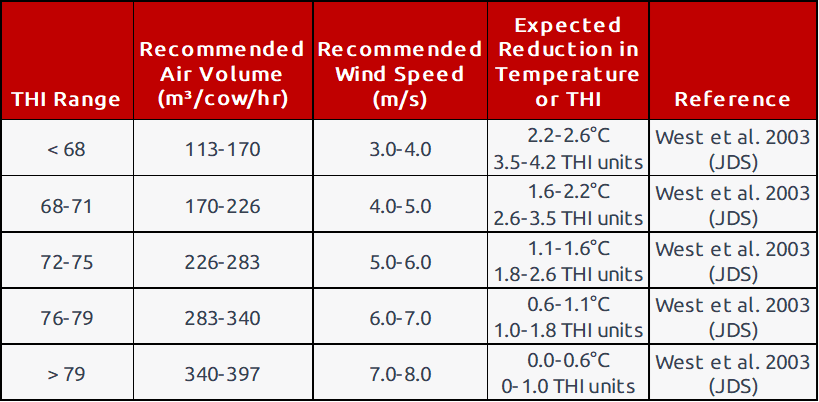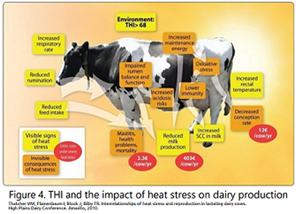Heat stress is a major problem in dairy farming. It results in reduced milk yield, fertility issues, and causing mortality. Heat stress in dairy cows begins when the temperature exceeds 20°C/68°F and becomes critical when the temperature is above 25°C/77°F, and relative humidity is over 60. The combination of temperature and humidity are summarized in Thermal Heat Index (THI) charts, which are associated with signals and consequences.

Acute effects are evident after 2 hours above THI threshold and chronic consequences are exacerbated if overnight cooling is not present and heat spell exceeds 3 days. In regions where THI can exceed 68 for 10 hrs./day, cooling should be considered in the building design (Roth et al (2020) JDS). There are several methods available for cooling cows, which include conduction, radiation, convection, and evaporation.

Conduction Cooling
Conduction cooling involves providing cows with a cool surface to lie on, which can be achieved by using rubber flooring or deep-bedded sand as opposed to hotter mats or straw packs. However, bedding material scarcity and the cost of implementation can be high (West, (2003) JDS).

Radiation Cooling
Radiation cooling involves providing cows with a cool environment for their bodies to radiate heat. Shade is an effective method for cooling cows, as it can help to reduce the temperature of the surrounding air and provide a cool area for cows to rest. This can be achieved by planting trees or using shade cloth or other materials, such as a reflective roof, to create a shaded area. This method is effective in reducing the temperature of the surrounding air, but it can be expensive to install and maintain. I.e., barn evaporative cooling walls. (West (2003) JDS).

Convection Cooling
Convection cooling is a method that involves moving air over the cow's body to remove heat. Fans are an effective way to achieve convection cooling. The necessary wind speed for fans to be effective is around 5 mph. Fans are low-cost and easy to install, making them a popular method for cooling cows (West (2003) JDS). A study found that fans reduced rectal temperature by 0.3°C and respiration rate by twelve breaths per minute. (Tucker et al. (2015), JDS).


Evaporation Cooling
Evaporation cooling involves cooling cows by providing them with a source of water to evaporate from their skin. Misters and soakers are effective methods of evaporation cooling. Misters spray a fine mist of water to cool the air or, if denser, over cows, which evaporates and cools the cows down. The pressure and droplet size of misters are crucial to ensure that the cows are effectively cooled without getting wet. The ideal droplet size is 50-60 microns, and the pressure should be around 60-80 psi. In Free cow flow barn, we need to be careful not to wet the resting area, as cows may lay down immediately after milking, and wet beds are incubators for environmental mastitis pathogens. Fans or mister sprays are the ideal cooling method in and around the milking robots.


Soakers provide a steady stream of water that wets the cow's skin, which evaporates and provides a cooling effect. Soakers can be placed in areas where cows tend to congregate, and the amount and frequency of use will depend on the farm's specific needs and resources. In robotic milking systems, it is not recommended to soak cows just prior, during or immediately after milking, because water running off the flanks can bring pathogens to the teat cup and open teat ends. Installing and maintaining cooling soakers has recently become more cost effective with the advent of ultrasonic cow presence sensors.


In Conclusion
Heat stress results in reduced milk yield, fertility issues, and mortality. The combination of temperature and humidity are summarized in Thermal Heat Index (THI), which is used as the standardized method of evaluating heat stress in cows. There are several methods available for cooling cows, which include conduction, radiation, convection, and evaporation.

Have you tried one or more of these cooling methods? Share your farm's experience in the comments!

-

mantaskavaliskas
-
Cancel
-
Vote Up
0
Vote Down
-
-
Sign in to reply
-
More
-
Cancel
Comment-

mantaskavaliskas
-
Cancel
-
Vote Up
0
Vote Down
-
-
Sign in to reply
-
More
-
Cancel
Children